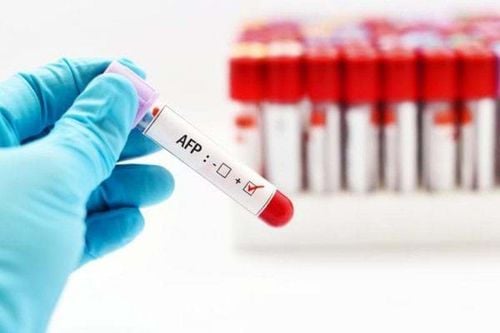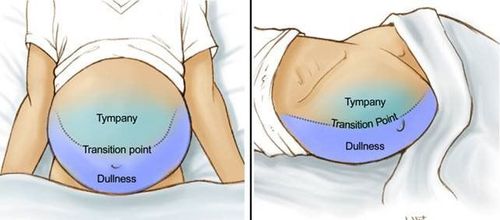This is an automatically translated article.
Peritoneal fluid is a fluid that acts as a lubricant in the abdominal cavity. In some cases, for various reasons, the amount of peritoneal fluid increases abnormally, causing different clinical manifestations. At this time, analysis of peritoneal and peritoneal fluid will be indicated to evaluate the cause and guide treatment.
1. When to perform peritoneal fluid test?
Peritoneal fluid normally exists in small quantities of about 100 mL between the peritoneal layers and is produced by the mesothelial cells in the peritoneum, which have a moisturizing effect on the outside of organs and reduce friction on the tissues. organs in the digestive system. However, a variety of causes and conditions can cause inflammation or excessive fluid accumulation to cause symptoms of ascites or peritoneal effusion. Peritoneal fluid testing will be indicated at this time when the patient has the following symptoms:
Ascites of unknown cause; Abdominal pain and sensitivity; Intestinal perforation; Suspected intra-abdominal malignancy. In addition, when testing peritoneal fluid, it can also distinguish the type of fluid accumulation to help diagnose or the cause of fluid accumulation, there are 2 reasons for fluid accumulation in the abdominal cavity including:
Imbalance between hydrostatic pressure Static pressure drains fluid from the blood vessel lumen and osmotic pressure holds fluid in the blood vessels. The fluid that builds up in this case, called perfusion, is usually caused by congestive heart failure or cirrhosis of the liver. Trauma or peritonitis produces fluid in the abdominal cavity called exudates. This fluid is usually caused by an infection, malignancy, or autoimmune disease.

Xét nghiệm dịch phúc mạc lúc này sẽ được chỉ định khi bệnh nhân có các biểu hiện đau bụng và nhạy cảm
2. What are the components of the peritoneal fluid test?
The peritoneal fluid after being taken from the patient will be observed, tested for cytology, quantified albumin, microbiological culture, total protein, culture and gram stain.
Observation: Most of the peritoneal fluid is clear and slightly yellow in color, the cases of blood in the peritoneal fluid must have at least 10000 red blood cells/μL for the ascites to turn pink and over 20000 red blood cells/μL for the ascites to turn pink. The fluid has a distinct red color of blood. Bloody peritoneal fluid may result from malignancy or vascular puncture. Cloudy and purulent discharge is more indicative of an infection. Cell Count: The cellular composition of a normal ascites will contain less than 500 WBCs/μL and 250 polymorphonuclear leukocytes/μL. Any infection can cause leukocytosis, suggesting peritonitis when the polymorphonuclear leukocyte count is >250/μL. Meanwhile, lymphocytes often predominate in TB peritonitis and metastatic cancer. Quantitative Albumin: To distinguish ascites due to portal hypertension or not due to portal hypertension, the difference between serum albumin and ascites (SAAG) is usually used. Calculated by subtracting the albumin value in serum from the amount of albumin in the ascites. SAAG directly corresponds to portal pressure, so if the cause of ascites is portal hypertension, the SAAG value will be above 1.1 g/dL Total protein quantification: Ascites is classified as secretions when the amount of protein is greater than or equal to 2.5 g/dL with an accuracy of only about 56%. If the SAAG is increased, it is accompanied by a high protein level, which is common in most cases of liver congestion. In contrast, low SAAG associated with increased protein intake is often characteristic of cancerous ascites. Gram Culture and Staining: The purpose of gram culture and staining is to detect bacteria in ascites, provided that specimens are immediately injected into blood culture bottles. It takes about 10,000 bacteria/mL to be detected in grams. In addition, if the cytological smear is reported to be 58-75% sensitive in detecting cases of ascites due to cancer. Although analysis of peritoneal and peritoneal fluid is simple, it needs to be performed at a medical facility with modern equipment and highly qualified technicians. Therefore, patients need to go to a reputable hospital to conduct examination and treatment immediately when there are signs of peritoneal effusion, ascites. Currently, Vinmec International General Hospital is one of the leading prestigious hospitals in the country, trusted by a large number of patients for medical examination and treatment. Not only the physical system, modern equipment: 6 ultrasound rooms, 4 DR X-ray rooms (1 full-axis machine, 1 light machine, 1 general machine and 1 mammography machine) , 2 DR portable X-ray machines, 2 multi-row CT scanner rooms (1 128 rows and 1 16 arrays), 2 Magnetic resonance imaging rooms (1 3 Tesla and 1 1.5 Tesla), 1 room for 2 levels of interventional angiography and 1 room to measure bone mineral density.... Vinmec is also the place to gather a team of experienced doctors and nurses who will greatly assist in diagnosis and detection. early signs of abnormality in the patient's body. In particular, with a space designed according to 5-star hotel standards, Vinmec ensures to bring the patient the most comfort, friendliness and peace of mind.
Please dial HOTLINE for more information or register for an appointment HERE. Download MyVinmec app to make appointments faster and to manage your bookings easily.













